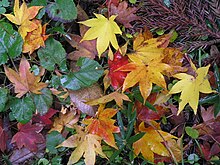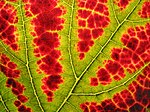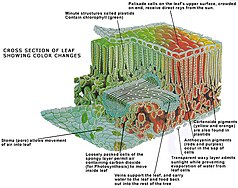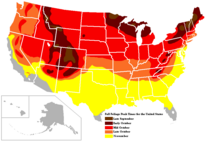
Chlorophyll is any of several related green pigments found in cyanobacteria and in the chloroplasts of algae and plants. Its name is derived from the Greek words χλωρός, khloros and φύλλον, phyllon ("leaf"). Chlorophyll allows plants to absorb energy from light.

Yellow is the color between green and orange on the spectrum of light. It is evoked by light with a dominant wavelength of roughly 575–585 nm. It is a primary color in subtractive color systems, used in painting or color printing. In the RGB color model, used to create colors on television and computer screens, yellow is a secondary color made by combining red and green at equal intensity. Carotenoids give the characteristic yellow color to autumn leaves, corn, canaries, daffodils, and lemons, as well as egg yolks, buttercups, and bananas. They absorb light energy and protect plants from photo damage in some cases. Sunlight has a slight yellowish hue when the Sun is near the horizon, due to atmospheric scattering of shorter wavelengths.

In the fields of horticulture and botany, the term deciduous means "falling off at maturity" and "tending to fall off", in reference to trees and shrubs that seasonally shed leaves, usually in the autumn; to the shedding of petals, after flowering; and to the shedding of ripe fruit. The antonym of deciduous in the botanical sense is evergreen.
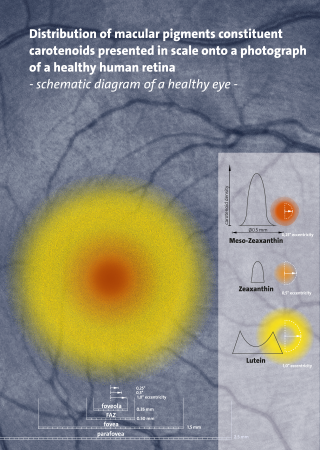
Carotenoids are yellow, orange, and red organic pigments that are produced by plants and algae, as well as several bacteria, archaea, and fungi. Carotenoids give the characteristic color to pumpkins, carrots, parsnips, corn, tomatoes, canaries, flamingos, salmon, lobster, shrimp, and daffodils. Over 1,100 identified carotenoids can be further categorized into two classes – xanthophylls and carotenes.

Chromoplasts are plastids, heterogeneous organelles responsible for pigment synthesis and storage in specific photosynthetic eukaryotes. It is thought that like all other plastids including chloroplasts and leucoplasts they are descended from symbiotic prokaryotes.
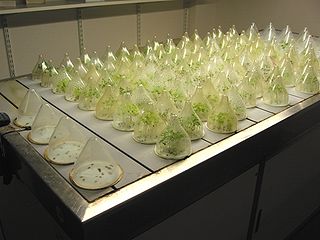
Plant physiology is a subdiscipline of botany concerned with the functioning, or physiology, of plants.

Agalychnis callidryas, commonly known as the red-eyed tree frog or red-eyed leaf frog, is a species of frog in the subfamily Phyllomedusinae. It is one of the most recognizable frogs. It is native to forests from Central America to north-western South America. This species is known for its bright coloration, namely its vibrant green body with blue and yellow stripes on the side. It has a white underside, brightly red and orange colored feet, and is named after its distinctive bright red eyes. One particular and special feature of the frogs coloration is its exceptional high reflectance in the near-infrared.

Abscission is the shedding of various parts of an organism, such as a plant dropping a leaf, fruit, flower, or seed. In zoology, abscission is the intentional shedding of a body part, such as the shedding of a claw, husk, or the autotomy of a tail to evade a predator. In mycology, it is the liberation of a fungal spore. In cell biology, abscission refers to the separation of two daughter cells at the completion of cytokinesis.
Herbivores are dependent on plants for food, and have coevolved mechanisms to obtain this food despite the evolution of a diverse arsenal of plant defenses against herbivory. Herbivore adaptations to plant defense have been likened to "offensive traits" and consist of those traits that allow for increased feeding and use of a host. Plants, on the other hand, protect their resources for use in growth and reproduction, by limiting the ability of herbivores to eat them. Relationships between herbivores and their host plants often results in reciprocal evolutionary change. When a herbivore eats a plant it selects for plants that can mount a defensive response, whether the response is incorporated biochemically or physically, or induced as a counterattack. In cases where this relationship demonstrates "specificity", and "reciprocity", the species are thought to have coevolved. The escape and radiation mechanisms for coevolution, presents the idea that adaptations in herbivores and their host plants, has been the driving force behind speciation. The coevolution that occurs between plants and herbivores that ultimately results in the speciation of both can be further explained by the Red Queen hypothesis. This hypothesis states that competitive success and failure evolve back and forth through organizational learning. The act of an organism facing competition with another organism ultimately leads to an increase in the organism's performance due to selection. This increase in competitive success then forces the competing organism to increase its performance through selection as well, thus creating an "arms race" between the two species. Herbivores evolve due to plant defenses because plants must increase their competitive performance first due to herbivore competitive success.

Acer is a genus of trees and shrubs commonly known as maples. The genus is placed in the soapberry family, Sapindaceae, along with lychee and horse chestnut. There are approximately 132 species, most of which are native to Asia, with a number also appearing in Europe, northern Africa, and North America. Only one species, Acer laurinum, extends to the Southern Hemisphere. The type species of the genus is the sycamore maple, Acer pseudoplatanus, the most common maple species in Europe. Maples usually have easily recognizable palmate leaves and distinctive winged fruits. The closest relatives of the maples are the horse chestnuts. Maple syrup is made from the sap of some maple species. It is one of the most common genera of trees in Asia. Many maple species are grown in gardens where they are valued for their autumn colour.

Biological pigments, also known simply as pigments or biochromes, are substances produced by living organisms that have a color resulting from selective color absorption. Biological pigments include plant pigments and flower pigments. Many biological structures, such as skin, eyes, feathers, fur and hair contain pigments such as melanin in specialized cells called chromatophores. In some species, pigments accrue over very long periods during an individual's lifespan.

Coleus scutellarioides, commonly known as coleus, is a species of flowering plant in the family Lamiaceae, native to southeast Asia through to Australia. Typically growing to 60–75 cm (24–30 in) tall and wide, it is a bushy, woody-based evergreen perennial, widely grown for the highly decorative variegated leaves found in cultivated varieties. Another common name is painted nettle, reflecting its relationship to deadnettles, which are in the same family. The synonyms Coleus blumei, Plectranthus scutellarioides and Solenostemon scutellarioides are also widely used for this species.

Animal colouration is the general appearance of an animal resulting from the reflection or emission of light from its surfaces. Some animals are brightly coloured, while others are hard to see. In some species, such as the peafowl, the male has strong patterns, conspicuous colours and is iridescent, while the female is far less visible.

Anthocyanins, also called anthocyans, are water-soluble vacuolar pigments that, depending on their pH, may appear red, purple, blue, or black. In 1835, the German pharmacist Ludwig Clamor Marquart named a chemical compound that gives flowers a blue color, Anthokyan, in his treatise "Die Farben der Blüthen". Food plants rich in anthocyanins include the blueberry, raspberry, black rice, and black soybean, among many others that are red, blue, purple, or black. Some of the colors of autumn leaves are derived from anthocyanins.
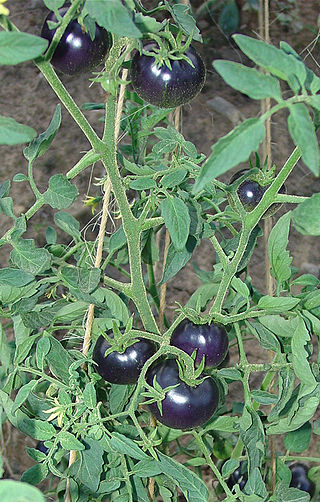
Blue tomatoes, also called purple tomatoes, are tomatoes that have been bred to produce high levels of anthocyanins, a class of pigments responsible for the blue and purple colours of many fruits, including blueberries, blackberries and chokeberries. Anthocyanins may provide protection for the plant against insects, diseases, and ultraviolet radiation. Some of these tomatoes have been commercialized under the names "Indigo Rose" and "SunBlack".

Psittacofulvin pigments, sometimes called psittacins, are responsible for the bright-red, orange, and yellow colors specific to parrots. In parrots, psittacofulvins are synthesized by a polyketide synthase enzyme that is expressed in growing feathers. They consist of linear polyenes terminated by an aldehyde group. There are five known psittacofulvin pigments - tetradecahexenal, hexadecaheptenal, octadecaoctenal and eicosanonenal, in addition to a fifth, currently-unidentified pigment found in the feathers of scarlet macaws. Colorful feathers with high levels of psittacofulvin resist feather-degrading Bacillus licheniformis better than white ones.

Acer palmatum, commonly known as Japanese maple, palmate maple, or smooth Japanese maple (Korean: danpungnamu, 단풍나무, Japanese: irohamomiji, イロハモミジ, or momiji,, is a species of woody plant native to Korea, Japan, China, eastern Mongolia, and southeast Russia. Many different cultivars of this maple have been selected and they are grown worldwide for their large variety of attractive forms, leaf shapes, and spectacular colors.

Autumn in New England begins in late September and ends in late December. It marks the transition from summer to winter and is known for its vibrant colors and picturesque beauty. The autumn color of the trees and flora in New England has been reported to be some of the most brilliant natural color in the United States; as such, it is a popular tourist destination, attracting visitors from across North America and overseas. Travelers flock to Vermont, New Hampshire, Maine, and parts of Massachusetts to see the colors each fall, a practice known as leaf peeping. Hiking during Autumn has become popular, and several areas offer guided tours.
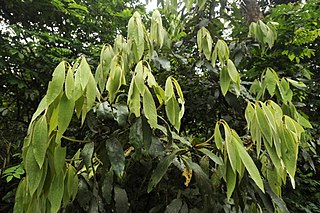
Leaf flushing or leaf out is the production of a flush of new leaves typically produced simultaneously on all branches of a bare plant or tree. Young leaves often have less chlorophyll and the leaf flush may be white or red, the latter due to presence of pigments, particularly anthocyanins. Leaf flushing succeeds leaf fall, and is delayed by winter in the temperate zone or by extreme dryness in the tropics. Leaf fall and leaf flushing in tropical deciduous forests can overlap in some species, called leaf-exchanging species, producing new leaves during the same period when old leaves are shed or almost immediately after. Leaf-flushing may be synchronized among trees of a single species or even across species in an area. In the seasonal tropics, leaf flushing phenology may be influenced by herbivory and water stress.

Floral color change occurs in flowers in a wide range of angiosperm taxa that undergo a color change associated with their age, or after successful pollination.
